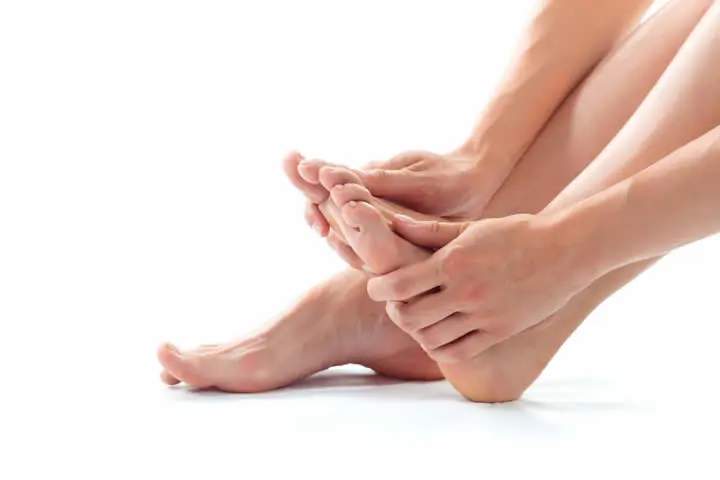What is Athlete’s Foot?
Athlete’s foot is a fungal skin infection that usually affects the area between the toes. It can cause itching, burning, scaling, peeling, and sometimes blisters on the feet. It is contagious and can spread through contact with infected skin or surfaces. Athlete’s foot can be treated with antifungal medications, but it may recur if not prevented.

What are the signs and symptoms of Athlete’s Foot?
Some of the signs and symptoms of athlete’s foot are:
- Itching, stinging, and burning between your toes or on the soles of your feet.
- Scaly, peeling, or cracked skin between the toes, on the bottom of the foot, or on the heel.
- Blisters on your feet that itch or ooze fluid.
- Thickened, crumbly, or discolored toenails (in rare cases).
What are the causes of Athlete’s Foot?
The causes of athlete’s foot are fungal infections that grow on the skin of the feet. The fungi that cause athlete’s foot are called dermatophytes. They can be spread through direct contact with someone who has the infection, or by touching surfaces that are contaminated with the fungi, such as towels, floors, and shoes. The fungi thrive in warm, moist environments, such as locker rooms, showers, and swimming pools. People who sweat a lot, wear tight shoes, or have minor skin injuries on their feet are more likely to get athlete’s foot.
What treatments are available at the dermatologist for Athlete’s Foot?
Some of the treatments that are available at the dermatologist for athlete’s foot are:
- Prescription-strength cream or ointment, such as clotrimazole (Lotrisone), econazole (Ecoza, Spectazole) or ciclopirox (Loprox, Penlac).
- Prescription antifungal pills, such as terbinafine (Lamisil) or itraconazole (Sporanox, Tolsura).
- Prescription antifungal cleanser, powder or lotion.
- Prescription antifungal drugs to prevent recurrence of severe cases.
These treatments are usually more effective than over-the-counter products and can clear up the infection faster. However, they may also have more side effects and interactions with other medications. You should consult your dermatologist before starting any treatment for athlete’s foot.

Athlete’s Foot: Myths and Facts
- Myth: Only athletes can get athlete’s foot.
- Fact: Anyone who is exposed to the fungus that causes athlete’s foot can get infected. The fungus likes to grow in warm, moist environments, such as locker rooms, showers, and swimming pools.
- Myth: Athlete’s foot is the same as jock itch.
- Fact: Athlete’s foot and jock itch are caused by the same type of fungus (dermatophytes), but they affect different parts of the body. Athlete’s foot affects the feet, while jock itch affects the groin area.
- Myth: Showering regularly can prevent athlete’s foot.
- Fact: Showering alone won’t prevent athlete’s foot. You need to dry your feet completely after each shower and avoid sharing towels, socks, or shoes with someone who has athlete’s foot. You should also wear shoes that allow your feet to breathe and change your socks often if you sweat a lot .
FAQ About Athlete’s Foot
Who is at risk of getting athlete’s foot?
Anyone who is exposed to the fungus that causes athlete’s foot can get infected. However, it most commonly affects men and people over the age of 60. You may be more likely to develop athlete’s foot if you have diabetes, obesity, a weakened immune system, tissue damage or wounds on your feet.
Is athlete’s foot contagious?
Yes, athlete’s foot is contagious and can spread through direct contact with an infected person or indirect contact with contaminated surfaces or objects. You can also spread it from your feet to other parts of your body, especially if you scratch or pick the infected area.
Can I get athlete’s foot from my pet?
Yes, you can get athlete’s foot from your pet if they have a fungal infection on their skin or nails. The same fungus that causes ringworm in animals can also cause athlete’s foot in humans. You should avoid touching your pet’s infected area and wash your hands after handling them. You should also take your pet to the vet for treatment.
Can I wear nail polish if I have athlete’s foot?
It is not advisable to wear nail polish if you have athlete’s foot because it can trap moisture and create a favorable environment for the fungus to grow. Nail polish can also prevent the medication from reaching the infected area and interfere with the healing process. You should remove any nail polish from your toenails before starting treatment for athlete’s foot.
Is there a dermatologist near me in San Jose that offers treatment for athlete’s foot?
Yes. At our San Jose dermatology office we offer treatment for Athlete’s Foot to patients from San Jose and the surrounding area. Contact our office today to schedule an appointment.

